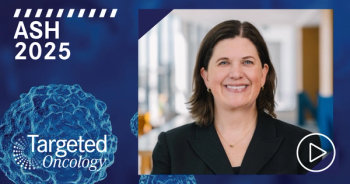
Challenges in Treating Myelofibrosis
Raajit Rampal, MD, PhD, discusses the challenges and unmet needs of myelofibrosis treatments and highlights promising investigational therapies.
Episodes in this series

Case: A 67-Year-Old Man With Myelofibrosis
Initial presentation
RF is a 67 y/o man who visits his primary care physician for his yearly checkup. He reports having fatigue and bone pain for the last few months. More recently, he’s been complaining of abdominal discomfort which he thinks is probably related to the big Thanksgiving dinner party, he and his wife hosted.
He enjoys spending time working on antique cars in his garage, but his wife says he becomes tired after just an hour.
RF has not noticed any changes in his eating habits, but his wife mentions he doesn’t eat as much as he used too. Upon examination, RF has lost close to 13 lbs. since this last yearly exam.
PMH:
Primary myelofibrosis diagnosed about 1 year ago
Diabetes (controlled with diet and exercise)
COPD
SMH: Smoked 3 packs/day but quit 5 years ago; he drinks occasionally
PE: abdominal exam reveals spleen palpable 5cm below left coastal margin, visible bruising
Initial Labs/Workup:
Platelet count: 184 x 109/L
Hgb: 10g/dL
WBC: 34 x 109/L
Bone Marrow Biopsy
Shows an increase in megakaryocytes
Bone Marrow Fibrosis
Megakaryocyte Atypia
Molecular testing
JAK-V617F mutation: positive
Initial treatment:
Patient was started on ruxolitinib 10mg BID when initially diagnosed
Current Presentation/Labs:
One year later, RF reports increasing fatigue and abdominal pain
Current Labs:
Platelet count: 57 x 109/L
Hgb: 8g/dL
WBC count: 29 x 109/L
Raajit Rampal, MD, PhD: For the last part of our discussion, what are the challenges in treating myelofibrosis? The ultimate challenge that we face is modifying therapy. A disease-modifying therapy, at least I think, is a therapy that eliminates the MF [myelofibrosis] stem cell. That's the biological answer. What is the practical answer? I think from the standpoint of the patient, it's a drug that allows the patient to live as normal a life as possible. Free of symptoms. Free of transfusions. And to live the longest life possible. Those are really the practical answers to what a disease-modifying therapy is in myelofibrosis. How do we get there? We have really solid building blocks from all the trials that we've talked about. The COMFORT trials, the JAKARTA trials, the PERSIST trials. That has allowed us to have access to these 3 JAK inhibitors. There are a number of different strategies being pursued to try to build upon these drugs that are currently FDA [United States Food and Drug Administration] approved for the treatment of this disease. That includes alternative JAK inhibitors. There is a drug called momelotinib that is currently in phase III trials. There is also a JAK inhibitor that includes trying to target other pathways that we know are important in myelofibrosis irrespective of targeting JAK2. These are drugs such as MDM2 inhibitors, such as KRT-232, which are in phase III trials. As well as drugs like imetelstat, which is a telomerase inhibitor that is currently in phase III trials. But it also includes a strategy of add-on. Add-on means that we take a patient, such as a patient in this particular scenario who is on ruxolitinib currently, and add inhibitors of other pathways that we know are pathogenic in the disease. There are currently a number of different examples, which are all exciting. There is a drug called parsaclisib, which is a PI3 kinase inhibitor that is being added to ruxolitinib in a randomized phase 3 trial. The phase 2 study certainly did demonstrate the ability to further reduce spleen size in patients who are on ruxolitinib. There is the MANIFEST-2 study, which is looking at the addition of the JAK inhibitor pelabresib to ruxolitinib in patients who are JAK inhibitor–naïve. This has previously been studied in MANIFEST-1 study both as a single agent as well as in an add-on to patients who are on ruxolitinib and who've had some prior exposure to ruxolitinib and it had demonstrated its ability to reduce spleen size and reduce symptom burden. Then there is another drug called navitoclax, which is a selective BCL-2 inhibitor that is currently being studied in phase 3 trial for untreated patients where patients either get ruxolitinib or the combination of ruxolitinib and navitoclax in combination. It's also being studied in the second line in patients who have previously been on ruxolitinib. To conclude, this is an exciting time in the field of myelofibrosis. Not only do we now have 3 approved JAK inhibitors, we now have several phase 3 studies of novel agents either as add-ons to current JAK inhibitors or as agents in and of themselves that are being evaluated. I think there is no doubt that how we treat this disease will evolve within the next 2 to 3 years. Thank you so much for your attention.
Transcript edited for clarity.









































